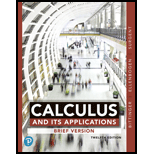
CALCULUS+ITS APPLICATIONS
12th Edition
ISBN: 9780135164884
Author: BITTINGER
Publisher: PEARSON
expand_more
expand_more
format_list_bulleted
Question
Chapter CR, Problem 62CR
To determine
The volume of the solid of revolution generated by rotating the region under the given graph in the given limits around the
Expert Solution & Answer
Want to see the full answer?
Check out a sample textbook solution
Students have asked these similar questions
=
5 37
A 4 8 0.5
06
9
Consider the following system of equations, Ax=b :
x+2y+3z - w = 2
2x4z2w = 3
-x+6y+17z7w = 0
-9x-2y+13z7w = -14
a. Find the solution to the system. Write it as a parametric equation. You can use a
computer to do the row reduction.
b. What is a geometric description of the solution? Explain how you know.
c. Write the solution in vector form?
d. What is the solution to the homogeneous system, Ax=0?
2. Find a matrix A with the following qualities
a. A is 3 x 3.
b. The matrix A is not lower triangular and is not upper triangular.
c. At least one value in each row is not a 1, 2,-1, -2, or 0
d. A is invertible.
Chapter CR Solutions
CALCULUS+ITS APPLICATIONS
Ch. CR - Prob. 1CRCh. CR - Prob. 2CRCh. CR - Prob. 3CRCh. CR - Prob. 4CRCh. CR - Prob. 5CRCh. CR - Prob. 6CRCh. CR - Prob. 7CRCh. CR - Prob. 8CRCh. CR - Prob. 9CRCh. CR - Prob. 10CR
Ch. CR - Prob. 11CRCh. CR - Prob. 12CRCh. CR - Prob. 13CRCh. CR - Prob. 14CRCh. CR - Prob. 15CRCh. CR - Prob. 16CRCh. CR - Prob. 17CRCh. CR - Prob. 18CRCh. CR - Prob. 19CRCh. CR - Prob. 20CRCh. CR - Prob. 21CRCh. CR - Prob. 22CRCh. CR - Prob. 23CRCh. CR - Prob. 24CRCh. CR - Prob. 25CRCh. CR - Prob. 26CRCh. CR - Prob. 27CRCh. CR - Prob. 28CRCh. CR - Prob. 29CRCh. CR - Prob. 30CRCh. CR - Prob. 31CRCh. CR - Prob. 32CRCh. CR - Prob. 33CRCh. CR - Prob. 34CRCh. CR - Prob. 35CRCh. CR - Prob. 36CRCh. CR - Prob. 37CRCh. CR - Prob. 40CRCh. CR - Prob. 41CRCh. CR - Prob. 42CRCh. CR - Prob. 43CRCh. CR - Prob. 44CRCh. CR - Prob. 45CRCh. CR - Prob. 46CRCh. CR - Prob. 47CRCh. CR - Prob. 48CRCh. CR - Prob. 49CRCh. CR - Prob. 50CRCh. CR - Prob. 52CRCh. CR - Prob. 54CRCh. CR - Prob. 55CRCh. CR - Prob. 56CRCh. CR - Prob. 57CRCh. CR - Prob. 58CRCh. CR - Prob. 59CRCh. CR - Prob. 61CRCh. CR - Prob. 62CRCh. CR - Prob. 63CRCh. CR - Suppose the rate of change of y with respect to x...Ch. CR - Prob. 65CRCh. CR - Prob. 66CRCh. CR - Prob. 67CRCh. CR - Prob. 68CRCh. CR - Prob. 69CRCh. CR - Prob. 70CRCh. CR - Prob. 71CRCh. CR - Prob. 72CR
Knowledge Booster
Learn more about
Need a deep-dive on the concept behind this application? Look no further. Learn more about this topic, calculus and related others by exploring similar questions and additional content below.Similar questions
- Find the exact area inside r=2sin(2\theta ) and outside r=\sqrt(3)arrow_forwardA 20 foot ladder rests on level ground; its head (top) is against a vertical wall. The bottom of the ladder begins by being 12 feet from the wall but begins moving away at the rate of 0.1 feet per second. At what rate is the top of the ladder slipping down the wall? You may use a calculator.arrow_forwardExplain the focus and reasons for establishment of 12.4.1(root test) and 12.4.2(ratio test)arrow_forward
- Use 12.4.2 to determine whether the infinite series on the right side of equation 12.6.5, 12.6.6 and 12.6.7 converges for every real number x.arrow_forwarduse Cauchy Mean-Value Theorem to derive Corollary 12.6.2, and then derive 12.6.3arrow_forwardExplain the focus and reasons for establishment of 12.5.4arrow_forward
arrow_back_ios
SEE MORE QUESTIONS
arrow_forward_ios
Recommended textbooks for you
 Elementary Geometry For College Students, 7eGeometryISBN:9781337614085Author:Alexander, Daniel C.; Koeberlein, Geralyn M.Publisher:Cengage,
Elementary Geometry For College Students, 7eGeometryISBN:9781337614085Author:Alexander, Daniel C.; Koeberlein, Geralyn M.Publisher:Cengage, Functions and Change: A Modeling Approach to Coll...AlgebraISBN:9781337111348Author:Bruce Crauder, Benny Evans, Alan NoellPublisher:Cengage Learning
Functions and Change: A Modeling Approach to Coll...AlgebraISBN:9781337111348Author:Bruce Crauder, Benny Evans, Alan NoellPublisher:Cengage Learning

Elementary Geometry For College Students, 7e
Geometry
ISBN:9781337614085
Author:Alexander, Daniel C.; Koeberlein, Geralyn M.
Publisher:Cengage,

Functions and Change: A Modeling Approach to Coll...
Algebra
ISBN:9781337111348
Author:Bruce Crauder, Benny Evans, Alan Noell
Publisher:Cengage Learning
Double and Triple Integrals; Author: Professor Dave Explains;https://www.youtube.com/watch?v=UubU3U2C8WM;License: Standard YouTube License, CC-BY